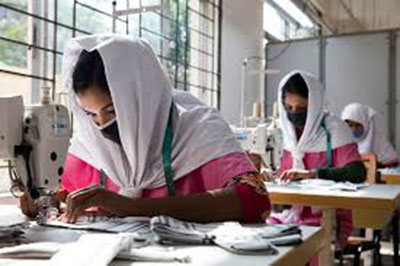
The coronavirus pandemic hits female workers the worst
Narayan Das | Sunday, 18 October 2020
To combat the novel coronavirus, many countries, including Bangladesh, imposed country-wide lockdown. The economy of Bangladesh was under the lockdown from late March to May 2020, when most economic activities slowed down. After withdrawing the lockdown, the economy started to revive. Many of those, however, who became unemployed during the lockdown were unable to return to jobs. The Power and Participation Research Centre (PPRC) and the BRAC Institute of Governance and Development (BIGD) at BRAC University conducted two surveys-one during the lockdown and another after the lockdown-to assess the effect of the Covid-19 on the livelihoods of rural and urban slum households. Findings from the first survey show that 54 per cent and 72 per cent of main earners from rural areas and urban slums were unemployed in early April 2020 though almost all of them were in jobs before the lockdown (February 2020). Findings from the second survey, on the other hand, indicate that after withdrawing the lockdown, the unemployment rate among the surveyed main earners declined to 17 per cent, indicating some recovery. In terms of earnings, however, the recovery was found to be very sluggish. For example, earnings of rickshaw pullers delined by 54 per cent in June-July 2020 compared to February 2020. These statistics suggest that the impact of the pandemic may last much longer than people had hoped in the beginning.

How are female workers affected by the pandemic compared to their male counterparts? In the PPRC-BIGD study, about 10.0 per cent and 15.0 per cent of respondents from rural areas and urban slums, respectively were females. Though the female respondents may be different from their male counterparts in terms of skills, education, and demographic characteristics, the second survey conducted by PPRC and BIGD reveals some significant differences in terms of employment impact across genders. In June-July 2020, when the second survey was conducted, the unemployment rate among male respondents varied between 8-20 per cent depending on the type of occupations. For females, by contrast, the rate varied between 16-54 per cent across the occupations analysed except for the transport sector in which female employment is generally very low. Housemaids (females) were the most severely affected group with an unemployment rate of 54 per cent in June-July 2020. Similarly, the unemployment rate among females engaged in small businesses was found to be very high (35 per cent).
Recently, BIGD, in collaboration with Australia's Monash University, conducted a study on the light engineering sector. The study reveals that 42 per cent of the male workers, employed in February 2020, became unemployed during the lockdown. The rate, however, came own to 15 per cent after the lockdown. By contrast, the corresponding rates among female workers were 51 per cent and 38 per cent. These statistics indicate that females were more likely to lose jobs during the lockdown and less likely to return to jobs after the lockdown. Similarly, as the study shows, earnings drop during and after the lockdown compared to pre-Covid was higher among female workers.
Another study conducted by UN Women shows that in Bangladesh, the proportion of people whose income from paid jobs decreased since the spread of Covid-19 is higher among women. Similarly, the study documents that the proportion of people who noted a decrease in income from farming and fishing since the spread of Covid-19 is higher among women.
Why are female workers affected more by the Covid-19 pandemic compared to male workers? There may be several reasons. Firstly, the occupation like housemaid is affected more by the pandemic because it may be that households that have elderly member(s) are less likely to employ any maid until the situation normalises. Second, in sectors like transport, wholesale and retail trade, female employment is very low; thus, compared to males, females have less chance to find another job if they become unemployed. This is revealed to some extent from the second survey conducted by PPRC and BIGD. The survey shows that among housemaids (females), 42 per cent remained in the same occupations, 5.0 per cent were employed in different occupations, and the rest become unemployed in June-July 2020. On the contrary, among rickshaw pullers (males), 80 per cent remained in the same occupations, 8per cent were employed in different occupations, and the rest become unemployed in June-July 2020.
The second survey conducted by PPRC and BIGD also reveals that the pandemic caused significant migration from urban to rural areas. Gender-disaggregated information on migration is not available in their study. However, females are perhaps more likely to be migrated from urban to rural areas as they were more likely to be unemployed due to the Covid-19 outbreak. Hence, it is likely that the coronavirus pandemic's long-term consequence is a higher unemployment rate among females in rural areas.
Overall it seems that the pandemic has hit female workers the worst in Bangladesh. Hence, policy interventions to recover the economy must pay special attention to female workers. Access to low-interest credits for females may be a useful tool. In this regard, the government may engage NGOs that have reputations to disburse credits to poor women. The prices of cattle feed and fodder should be reduced through government subsidy such that more poor women are engaged in livestock rearing-an activity that predominantly employs women. Policies should also be undertaken to increase female employment in sectors like transport. In this regard, providing subsidised driving training to female youth from low-income families may increase their employment in this sector. Ensuring the safety of female drivers is also important. Bangladesh should also explore international markets to increase female migration. Female migration from Bangladesh is currently low (around 15 per cent in 2019). Soft skills training (such as language training) to potential female migrants may be effective in increasing female migration.
Dr. Narayan Das is a Senior Research Fellow at BRAC Institute of Governance and Development, BRAC University.
narayan.das@bracu.ac.bd